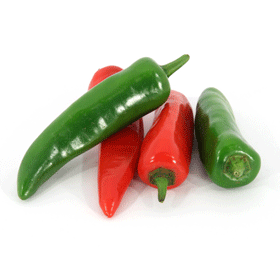
 |
|||||
|
|
|
|
|
|
|
|
What's Hot Is Hot! by Lisl Richards Bambas |
|

Long used by the Indians of the Americas, the pepper has arrived on the modern culinary scene with a vengeance. Pepper enthusiasts have entire journals devoted to their favorite subject. Walls and coffee tables are littered with brilliant photographic expressions of their rich colors, shapes, and sizes. Bookshelves are groaning under the weight of the latest chile recipe books and the many tomes of how to grow them. Pick up the food section in any newspaper and there's sure to be a new pepper recipe, an article about the health benefits of peppers, or a new restaurant specializing in the fiery foods of the Southwest or Orient. Texas A & M University has even developed the TAM mild jalapeño for those enthusiasts who love the taste but can't take the hot. Capsaicin, the active ingredient that puts the fire in the belly, has been touted for its curative powers for muscle aches as well as arthritis, headaches, and the common cold. Dieters are enthusiastically incorporating peppers into their regimen as they are said to raise the metabolism thus helping burn off excess fat. Peppers are also known to have a high content of vitamin C. Researchers are studying the curative powers of capsaicin on some lung and stomach cancers. Peppers salves are being used to bring relief to the pain of surgical scars. Food fairs are bursting with new salsas. Dining tables are no longer graced by mere salt and pepper but a myriad of pepper concoctions. Chef Madeline Bambas of Madeline's Gourmet has been experimenting with pepper sauces for the last ten years. Famous for her marinated jalapeño sauces, she began with a mixture of jalapeños, olive oil, garlic, and onions then went on to develop variations for people who were allergic to onions or couldn't have garlic. Then she turned to the serrano pepper which looks like a slimmer version of the jalapeño but has a fruitier taste and measures hotter on the Scoville scale. |

Yes, "chiliheads" have not one but three different ways to measure the burning sensation of peppers, the Scoville named after the pharmacist William Scoville which measures the capsaicinoids in a pepper, the Official Chile Heat Scale which is more of a taste consensus, and the high performance liquid chromatography (HPLC) which presents the researchers with a computer generated graph of the heat creating molecules. "Hot is good," laughs Madeline, "but you still have to have taste!" "Now people are crazy about hot and sweet things," Madeline adds. "Jellies, relishes, sweet hot pickles, and candied jalapeños are crowding out the salsas." Then there's the habanero. Touted as being the hottest pepper on the market, the brilliant yellow and orange fruits resemble a somewhat squashed miniature bell. Habaneros will send a hard core pepper enthusiast into raptures. It has a subtle, apricot-like, taste followed by a heat explosion. Even pepper sauce contests have been known to ban pure habanero salsas from public tastings due to their excessive fiery taste. "We mix some of our habaneros with carrots," says Madeline. "The sweet blandness of the carrot tames the excessive heat factor without altering the flavor, but watch out, the results will still fire off the top of your head." Habenaros can be found in jellies, sauces, mustards, and even lollipops. Somewhat of a cross between the jalapeño and the habanero in the pain factor lies the mansano pepper, now beginning to show up in markets. "Take small slivers, and add it to your fish with garlic, sweet peppers, and onions," suggests Madeline, "or throw some in your homemade barbecue sauce or soup." Wander through the pepper section of the condiment aisles or pick out a few fresh peppers. Experiment. It's good, and good for you -- as Madeline is fond of saying, "Eat, and enjoy!"
|
Scoville Heat Unit Scale
|
|||||||||||||||||||||||||||||||||||||||||||
|
Copyright © 2008 Epicurean.com All rights reserved |